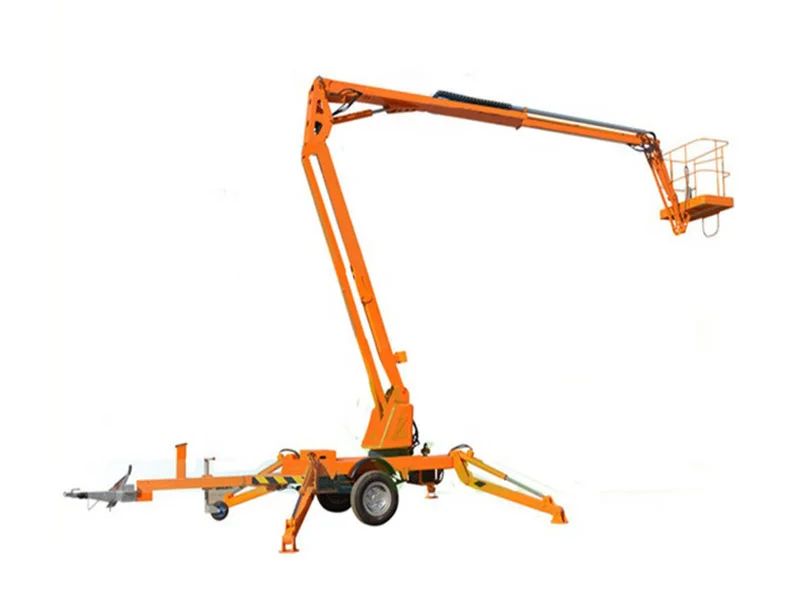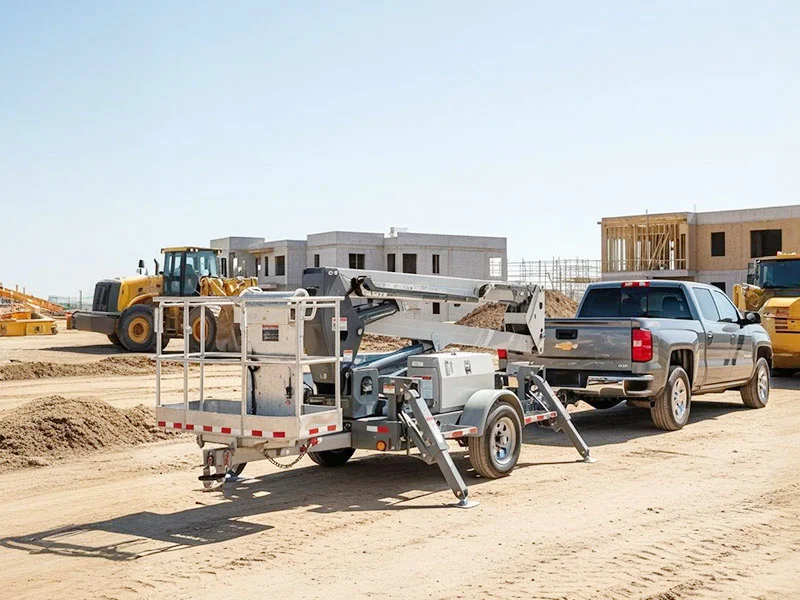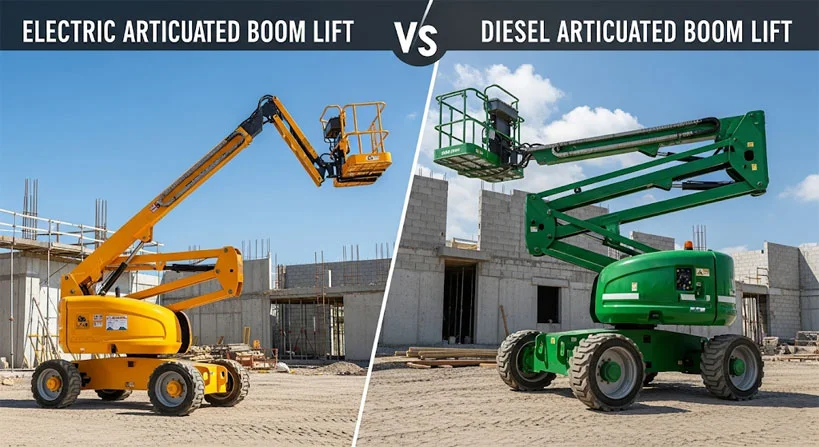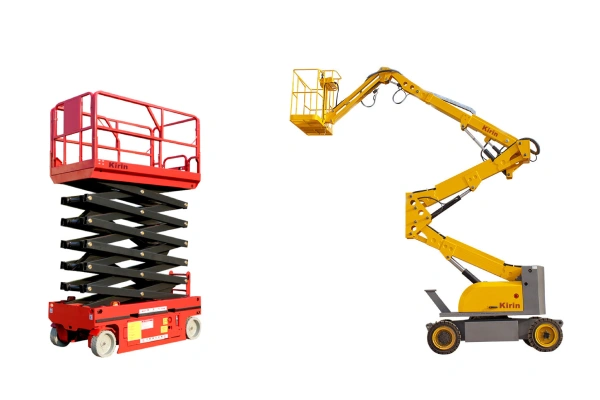When it comes to working at height, boom lifts are indispensable tools. But if you’re considering a small boom lift for your next project, one of the most crucial questions you’ll likely ask is: “How much does a small boom lift weigh?” Understanding the weight of these compact aerial lifts is vital for transportation, site assessment, and overall safety.

Lifting Your Knowledge – The Importance of Boom Lift Weight
Knowing the weight of a small boom lift is far more than just a trivia point. It directly impacts:
- Transportation: Can your existing trailer or truck haul it? Do you need special permits?
- Ground Pressure: Will it damage sensitive flooring or soft ground?
- Site Accessibility: Can it be maneuvered into position without issues?
- Safety: Is the ground stable enough to support the lift and its load?
Ignoring the weight can lead to costly delays, damage, or, most importantly, dangerous situations.
What Qualifies as a “Small Boom Lift”?
The term “small boom lift” isn’t a strictly defined industry standard, but it generally refers to models designed for compact spaces and lighter-duty tasks. These often include:
- Electric or Hybrid Models: Often lighter due to battery power and less reliance on heavy hydraulic components.
- Articulating Boom Lifts: While some larger articulating models exist, smaller versions offer excellent maneuverability in confined areas.
- Telescopic Boom Lifts: Shorter reach models, typically under 40-50 feet of platform height, can fall into this category.
- Towable Boom Lifts: These are inherently designed to be lighter for easier towing.
They typically offer platform heights ranging from 20 to 50 feet and have more compact dimensions than their larger counterparts.

Typical Weight Ranges for Small Boom Lifts
So, how much does a small boom lift weigh? The weight can vary significantly depending on the type, features, and manufacturer. However, you can generally expect a small boom lift to fall within these ranges:
- Towable Boom Lifts: These are often the lightest, ranging from 2,500 lbs to 5,000 lbs (approx. 1,130 kg to 2,270 kg). Their design prioritizes portability.
- Electric/Hybrid Articulating Boom Lifts (Compact Models): These can weigh anywhere from 6,000 lbs to 12,000 lbs (approx. 2,720 kg to 5,440 kg). The batteries and electric motors contribute to the weight, but they are still much lighter than their diesel-powered, larger counterparts.
- Compact Diesel Articulating or Telescopic Boom Lifts: While still considered “small” in their class, these can be heavier due to the engine and robust construction, often in the range of 8,000 lbs to 15,000 lbs (approx. 3,630 kg to 6,800 kg).
It’s crucial to consult the manufacturer’s specifications for the exact weight of any given model.
Key Factors That Influence a Boom Lift’s Weight
Several factors contribute to the overall weight of a small boom lift:
- Power Source: Electric models are generally lighter than diesel-powered ones due to the absence of a heavy engine block and fuel tank.
- Reach and Platform Height: Longer booms and higher reach capabilities require more robust (and thus heavier) construction materials.
- Type of Boom: Articulating booms, with their multiple pivot points, can sometimes be heavier than telescopic booms of similar reach, although this isn’t always the case for compact models.
- Outriggers/Stabilizers: Lifts designed for rough terrain or higher reach often have heavier, more extensive outrigger systems for stability.
- Tires/Tracks: Solid non-marking tires or tracks can add significant weight compared to pneumatic tires.
- Attachments and Accessories: Any added features like specialized platforms, generators, or material handling attachments will increase the total weight.
Why Does the Weight of a Small Boom Lift Matter?
Beyond the initial transportation considerations, the weight of a small boom lift has broader implications:
- Floor Loading Capacity: Crucial for indoor projects where floors have specific weight limits. Overloading can cause structural damage.
- Ground Conditions: Soft ground, asphalt, or sensitive landscapes can be easily damaged by heavy equipment. A lighter small boom lift minimizes this risk.
- Permitting and Regulations: Depending on your location, transporting oversized or overweight equipment might require special permits and adherence to specific regulations.
- Fuel Efficiency/Power Consumption: While less direct, a heavier machine generally requires more power to operate and move, potentially impacting fuel efficiency or battery life.

Practical Considerations When Dealing with Boom Lift Weight
Before renting or purchasing a small boom lift, always:
- Check the Manufacturer’s Specifications: This is the most accurate source for the lift’s operating weight.
- Assess Your Transport Capabilities: Ensure your trailer, truck, and any towing equipment are rated to handle the boom lift’s weight plus any additional gear.
- Evaluate the Job Site: Consider the ground conditions, floor loading limits, and any obstacles that might be affected by the lift’s weight.
- Plan for Movement: If the lift needs to be moved around the site frequently, a lighter model might be more practical.
- Factor in Ballast (if applicable): Some boom lifts use ballast for stability, which contributes to the overall operating weight.
Conclusion: Making an Informed Decision
Understanding “how much does a small boom lift weigh” is a fundamental step in selecting the right equipment for your needs. By considering the various factors that influence weight and the practical implications, you can ensure safe, efficient, and cost-effective operations. Always prioritize safety and consult detailed specifications to make an informed decision when it comes to your compact aerial lift.
FAQs
Q: Can I tow a small boom lift with a standard pickup truck?
A: It depends on the specific boom lift’s weight and your truck’s towing capacity. Many towable small boom lifts are designed to be towed by heavy-duty pickup trucks, but always check both the lift’s weight and your truck’s towing specifications.
Q: Do all small boom lifts have outriggers?
A: Not all. Some very compact or scissor-style lifts may not require outriggers. However, many articulating and telescopic small boom lifts use outriggers or stabilizers for enhanced stability, especially when operating at height or on uneven ground.
Q: How does the weight of a small boom lift affect its rental cost?
A: While not a direct linear relationship, heavier lifts often have higher transportation costs due to specialized hauling requirements. This can indirectly influence the overall rental cost. The size and capabilities of the lift are usually bigger factors in pricing.


